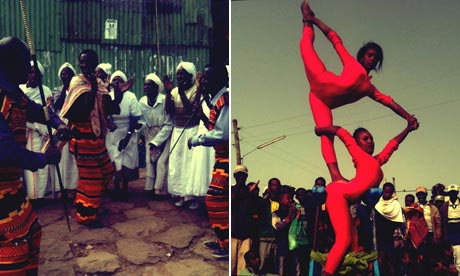The living Legend and The father of Ethio Jazz - Mulatu Astateka
video http://www.diretube.com/sunday-special/the-living-legend-and-the-father-of-ethio-jazz-mulatu-astateka-video_3debdf7be.html
Mulatu Astatke (surname also spelled Astatqé) (Amharic: ሙላቱ አስታጥቄ) is an Ethiopian musician and arranger.
He is known as the father of Ethio-jazz. Born in 1943 in the western Ethiopian city of Jimma, Mulatu was musically trained in London, New York City, and Boston, where he was the first African student at Berklee College of Music.
He would later combine his jazz and Latin music influences with traditional Ethiopian music.
He has worked with many influential jazz artists such as Duke Ellington during the 1970s. After meeting the Massachusetts-based Either/Orchestra in Addis Ababa in 2004, Mulatu began a collaboration with the band which continues today, with the most recent performances in Scandinavia in summer 2006 & London, New York, Germany, Holland, Glastonbury (UK), Dublin and Toronto in summer 2008.
In the autumn of 2008, he collaborated with London-based Psyche-Jazz collective, The Heliocentrics on an album 'Inspiration Information Vol. 3' which included re-workings of his earlier Ethio-Jazz classics with new material by The Heliocentrics and himself. Mulatu's signature instrument is the vibraphone.
In 2005, his music appeared on the soundtrack to the Jim Jarmusch film Broken Flowers. In addition, Volume 4 of the Ethiopiques series is devoted entirely to Mulatu's music.
Mulatu has also produced songs for many artists from East Africa, including Mahmoud Ahmed.Mulatu released a two-disc set to be sold exclusively to passengers of Ethiopian Airlines, with the first disc being a compilation of the different styles from different regions of Ethiopia and the second being studio originals.
In 2007 and 2008, Mulatu completed a Radcliffe Institute Fellowship at Harvard University where he worked on modernizations of traditional Ethiopian instruments and premiered a portion of a new opera, "The Yared Opera."1 Mulatu also recently served as an Abramowitz Artist-in-Residence at the Massachusetts Institute of Technology in Cambridge, MA.
In addition to a lecture and workshops, Mulatu served as an advisor to the MIT Media Lab on creating a modern version of the krar, a traditional Ethiopian instrument, for which he will return to MIT briefly in spring 2009 to check on its progress.
On February 1, 2009, Mulatu Astatke performed at the Luckman Auditorium in Los Angeles with a band including such notable jazz musicians as Bennie Maupin, Azar Lawrence, and Phil Ranelin.
video http://www.diretube.com/sunday-special/the-living-legend-and-the-father-of-ethio-jazz-mulatu-astateka-video_3debdf7be.html
Mulatu Astatke (surname also spelled Astatqé) (Amharic: ሙላቱ አስታጥቄ) is an Ethiopian musician and arranger.
He is known as the father of Ethio-jazz. Born in 1943 in the western Ethiopian city of Jimma, Mulatu was musically trained in London, New York City, and Boston, where he was the first African student at Berklee College of Music.
He would later combine his jazz and Latin music influences with traditional Ethiopian music.
He has worked with many influential jazz artists such as Duke Ellington during the 1970s. After meeting the Massachusetts-based Either/Orchestra in Addis Ababa in 2004, Mulatu began a collaboration with the band which continues today, with the most recent performances in Scandinavia in summer 2006 & London, New York, Germany, Holland, Glastonbury (UK), Dublin and Toronto in summer 2008.
In the autumn of 2008, he collaborated with London-based Psyche-Jazz collective, The Heliocentrics on an album 'Inspiration Information Vol. 3' which included re-workings of his earlier Ethio-Jazz classics with new material by The Heliocentrics and himself. Mulatu's signature instrument is the vibraphone.
In 2005, his music appeared on the soundtrack to the Jim Jarmusch film Broken Flowers. In addition, Volume 4 of the Ethiopiques series is devoted entirely to Mulatu's music.
Mulatu has also produced songs for many artists from East Africa, including Mahmoud Ahmed.Mulatu released a two-disc set to be sold exclusively to passengers of Ethiopian Airlines, with the first disc being a compilation of the different styles from different regions of Ethiopia and the second being studio originals.
In 2007 and 2008, Mulatu completed a Radcliffe Institute Fellowship at Harvard University where he worked on modernizations of traditional Ethiopian instruments and premiered a portion of a new opera, "The Yared Opera."1 Mulatu also recently served as an Abramowitz Artist-in-Residence at the Massachusetts Institute of Technology in Cambridge, MA.
In addition to a lecture and workshops, Mulatu served as an advisor to the MIT Media Lab on creating a modern version of the krar, a traditional Ethiopian instrument, for which he will return to MIT briefly in spring 2009 to check on its progress.
On February 1, 2009, Mulatu Astatke performed at the Luckman Auditorium in Los Angeles with a band including such notable jazz musicians as Bennie Maupin, Azar Lawrence, and Phil Ranelin.






